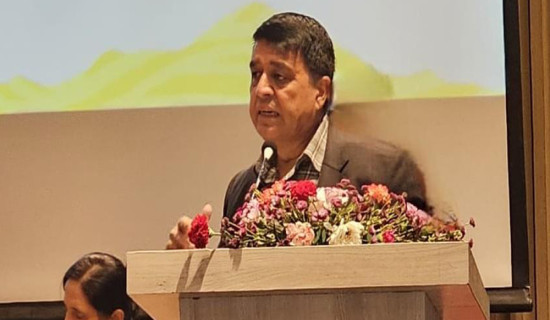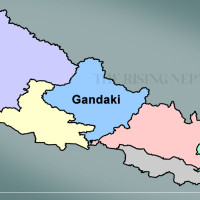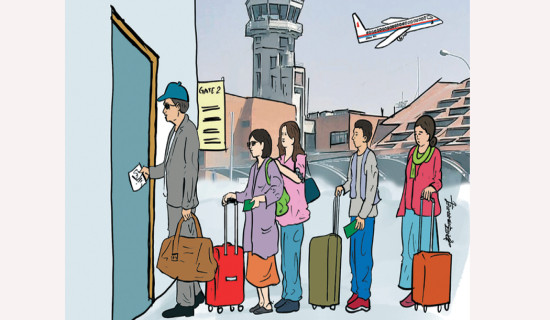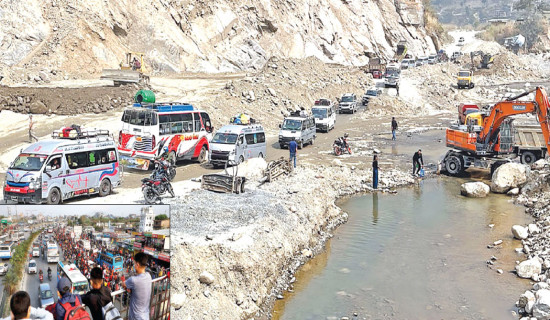- Thursday, 25 December 2025
Govt races to fix highways ahead of festive exodus
Kathmandu, Sept. 4: With major festivals like Dashain, Tihar, and Chhath approaching, the Department of Roads (DoR) has unveiled a strategic plan to ensure seamless and secure travel on key highways, despite numerous monsoon-induced blockages that have persisted for months.
The condition of national highways so far can be termed as ‘normal’ and that repair work for flood and landslide damage is ongoing, said Director General for the Department, Bijaya Jaishi.
DG Jaishi said that teams with machinery have been pre-deployed to high-risk landslide zones to clear obstructions immediately.
The Department has also said that all potholes and road cavities along the route will be filled and repair works completed by mid-September.
“Priority is being accorded to mitigating potential obstructions from floods and landslides during the monsoon, with teams equipped with machinery pre-deployed in areas identified as high-risk zones,” said Jaishi.
He added that all potholes on the crucial Nagdhunga–Malekhu–Mungling road section will be filled and repairs completed by mid-September.
However, this claim of normalcy contradicts with the reality on the ground. Several major highways across the country have been blocked for extended periods. Araniko Highway has been closed for a month and with seven identified high-risk landslide points.
The Department has identified seven specific high-risk landslide points along the Araniko Highway that include Kothe Landslide, Mahabhir Landslide, Bulkot Landslide, Daklang Landslide, Koplang Landslide, Kodari Landslide, and Jure Landslide.
The Galchhi-Syafrubesi-Rasuwagadhi road, damaged by a flood from China on July 8, is currently open only for one-way traffic from Syafrubesi to Timure. The key Miteri Bridge, severing the trans-border link, was washed away. Rebuilding the bridge on the Nepali side is delayed due to high water flow.
The Koshi Corridor has been blocked since mid-July after the Arun River swept away a diversion. Similarly, the Tamor Corridor in Taplejung has been blocked since July 23.
Importantly, the lifeline to eastern Nepal, the BP Highway, was severely damaged in late September, with approximately 29 kilometres destroyed. It currently operates on a temporary track and remains highly vulnerable to rainfall.
According to the Department, on the Arniko Highway, 11 pieces of equipment are in place, with six provided by the Department and five sourced from construction companies.
The BP Highway has an even larger contingent, with 35 units strategically positioned; 22 of these are from the Department and 13 are from partnering companies.
Across the country, a total of 277 equipment units are standby for monsoon response, said the Department. To ensure a rapid response to any incidents, 154 units have been pre-positioned at identified high-risk locations, while the remaining 123 are on a ready-alert status at various Department offices.
The Department has a mandated policy for key highways like the Kantipath, Prithvi Highway, and East-West Highway that equipment must be mobilised within 30 to 60 minutes of a blockage, and the road must be reopened for one-way traffic within four hours.
Regarding permanent repairs on the BP Highway, contracts have been awarded for all but 2.5 kilometres of the 29km damaged section. While three sections have been contracted out, one will be handled by the Department’s own workforce.
Despite the extensive damage and blockages, the Department has assured that contingency plans are in place to reopen highways immediately should they become blocked during the upcoming festive season, prioritising the mobility of the thousands of travellers returning home.
















